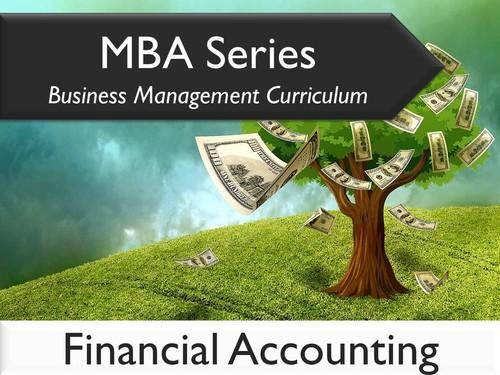Oreilly - MBA Series Business Management Curriculum: Financial Accounting
by Tahseen Rehman | Publisher: Technics Publications | Release Date: September 2019 | ISBN: 9781634626088
Follow along with certified financial accounting expert Tahseen Rehman and learn how to read and analyze the financial statements within your organization. In this course on financial accounting, interpret the income statement, balance sheet, and statement of cash, as well as other important financial documents. Learn about accrual accounting and its impact on expenses and revenue. Perform cash flow and ratio analysis. The MBA Series contains three curriculums: Business Management, Business Development, and Business Communication. This course, Financial Accounting, is a core course within the Business Management curriculum. Follow this link to take all of the courses in the MBA Series here on O'Reilly. This financial accounting course contains 15 topics: Introducing Financial Accounting. This first topic in the financial accounting course introduces you to the world of financial accounting. In addition to receiving an overview to the topics that will be covered in this video series, learn the definition of financial accounts, know why financial accounting is important, and identify the main consumers of financial information. Developing a Proficiency Financial Accounting Concepts. This second topic in the financial accounting course covers all of the basic and some of the advanced financial account concepts. Learn about the balance sheet, income statement, statement of changes in equity, cash flow statement, and notes to the financial statement. Be able to explain the elements of assets, liabilities, capital/equity, income, and expense. Be able to explain the concepts of accrual basis, consistency, completeness, relevance, materiality, prudence, going concern basis, and substance over form. Practicing Double Entry. This third topic in the financial accounting covers double entry bookkeeping. Learn the basic rules of double entry bookkeeping. Be able to explain the debit items of assets and expenses and the credit items of equity, liability, and income, and how to apply all of these to T accounts. Following the Flow of Transactions. This fourth topic in the financial accounting course will equip you to explain the flow of transactions, from T-accounts to trial balances, to financial statements. Introducing Accruals and Prepayments. This fifth topic in the financial accounting course will equip you to process accruals and prepayments. Introducing Estimates and Provisions. This sixth topic in the financial accounting course will equip you to make estimates and provisions, which are used for recording depreciation of fixed assets and for allowance for bad and doubtful debts. Be able to explain important depreciation concepts including depreciable amount, residual value, and useful life. Practice the Straight Line and Reducing Balance methods for depreciation. Introducing Property, Plant, and Equipment (PPE). This seventh topic in the financial accounting course will explain in detail Property, Plant, and Equipment (PPE). Also be able to explain Cost of Land and Land Improvements, exchange transactions, subsequent expenditure, and depreciation. Preparing the Trial Balance. This eighth topic in the financial accounting course will equip you to calculate a trial balance, which is a list of all of the balances standing on the ledger account at any given date. Preparing the Balance Sheet. This ninth topic in the financial accounting course will equip you to prepare the balance sheet. The items on a balance sheet are explained, along with best practices for creating a balance sheet. Preparing the Income Statement. This tenth topic in the financial accounting course will equip you to prepare the income statement. The items on an income statement are explained, along with best practices for creating an income statement. Learn about the classification of expenses. Preparing the Cash Flow Statement. This 11th topic in the financial accounting course will equip you to prepare the cash flow statement. The items on a cash flow are explained, along with best practices for creating a cash flow statement. Learn about the difference between profit and cash flow. Using Ratio Analysis. This 12th topic in the financial accounting course will equip you to use ratio analysis. Know the uses of ratio analysis, including to analyze the performance trends over a period of time, compare financial results with competitors, make decision making easier, and point out problem areas. The categories of financial ratios are explained, including financial performance ratios, working capital turnover ratios, liquidity ratios, and debt ratios. A number of important ratios are discussed, including Return on Shareholder Equity, profit to sales ratio, asset turnover ratio, and Return on Assets (ROA). Analyzing Financial Statements. This 13th topic in the financial accounting course will equip you to analyze balance sheets, income statements, and cash flows. You will use horizontal analysis, vertical analysis, and ratio analysis. The limitations of financial statement analysis are covered. Interpreting the Statement of Changes in Equity (SOCE). This 14th topic in the financial accounting course will equip you to interpret the Statement of Changes in Equity (SOCE). SOCE shows for each component of equity the amount at the beginning of the period, changes during the period, and the amount at the end of the period. The components of a SOCE are covered, including Share Capital, Share Premium, Redemption, Dividend, Bonus Shares, Right Issue, and Retained Earnings. Introducing Financial Instruments and Consolidation. This 15th topic in the financial accounting course will equip you to explain financial instruments and perform consolidations. Many concepts are covered including Non-Controlling Interest (NCI), Consolidated Retained Earnings, and Control.
- Introducing Financial Accounting 00:10:53
- Developing a Proficiency Financial Accounting Concepts 00:22:13
- Practicing Double Entry 00:07:48
- Following the Flow of Transactions 00:03:41
- Introducing Accruals and Prepayments 00:09:56
- Introducing Estimates and Provisions 00:14:28
- Introducing Property, Plant, and Equipment (PPE) 00:22:32
- Preparing the Trial Balance 00:02:30
- Preparing the Balance Sheet 00:08:38
- Preparing the Income Statement 00:07:34
- Preparing the Cash Flow Statement 00:23:14
- Using Ratio Analysis 00:27:02
- Analyzing Financial Statements 00:10:43
- Interpreting the Statement of Changes in Equity (SOCE) 00:18:20
- Introducing Financial Instruments and Consolidation 00:47:50






